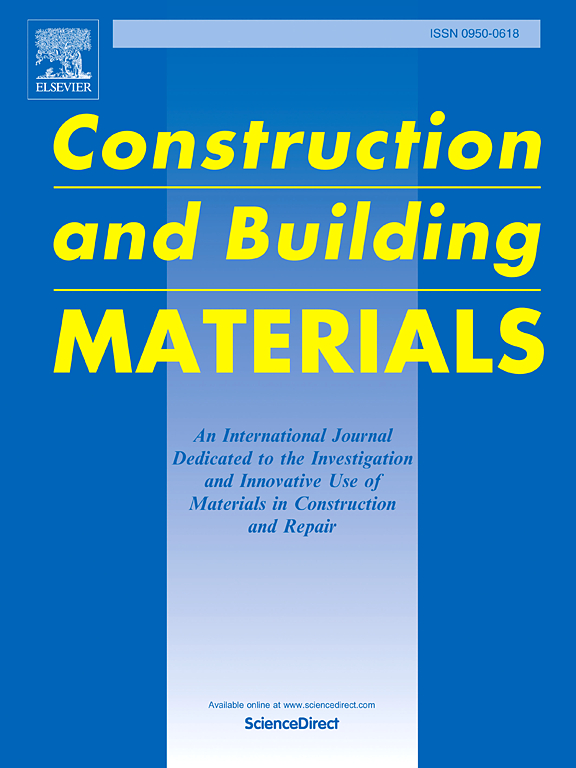Flexural behaviour of concrete beams repaired by hybrid fibre reinforced cementitious composites (HFRCCs) and subjected to simulated seawater dry-wet cycles
IF 7.4
1区 工程技术
Q1 CONSTRUCTION & BUILDING TECHNOLOGY
引用次数: 0
Abstract
To develop innovative strategies for enhancing the durability of marine concrete structures, hybrid fibre-reinforced cement-based composites (HFRCCs) were used to repair small concrete beams. This study investigated the effects of steel fibre content (0 % to 0.5 % by volume) combined with 1.5vt% polyvinyl alcohol (PVA) fibres, HFRCC layer depth (0–50 mm) and simulated seawater dry-wet cycles (0−40) on the flexural behaviour of repaired beams, with three specimens per series). Results indicated that increasing steel fibre content from 0 % to 0.5 % by volume improved both flexural strength and deflection-hardening behaviour. The optimal composition - 0.15 % steel fibres and 1.5 % PVA fibres, both by volumes - enhanced flexural strength by up to 20 %. A 52 % increase in flexural strength was achieved by increasing the HFRCC layer depth to 30 mm in beams with 0.25 % steel fibres and 1.5 % PVA fibres. Beams with 0.15 % steel fibres and 1.5 % PVA fibres exhibited superior deflection-hardening behaviour, characterised by significant strength gains and enhanced post-cracking toughness. Seawater exposure up to 20 cycles initially increased flexural strength due to continued hydration, while prolonged exposure to 40 cycles reduced flexural strength by 24 %, likely due to chloride accumulation in matrix pores. Based on these parameters, a new equation for predicting the flexural strengths of repaired beams was proposed. Finally, strain analysis confirmed strong compatibility between the HFRCC layer and concrete, improving durability and load-bearing capacity of repaired beams in marine environments. These findings contribute to optimised repair strategies for marine concrete structures, enhancing resilience and structural integrity in harsh environments.
混合纤维增强胶凝复合材料修复混凝土梁的抗弯性能及模拟海水干湿循环
为了开发提高海洋混凝土结构耐久性的创新策略,混合纤维增强水泥基复合材料(hfrcc)被用于修复小型混凝土梁。本研究调查了钢纤维含量(0 %至0.5 %体积比)与1.5vt%聚乙烯醇(PVA)纤维、HFRCC层深度(0 - 50 mm)和模拟海水干湿循环(0 - 40)对修复梁抗弯性能的影响,每个系列有三个试件)。结果表明,钢纤维体积含量从0 %增加到0.5 %,提高了材料的抗弯强度和挠曲硬化性能。最佳成分- 0.15 %钢纤维和1.5 %聚乙烯醇纤维,体积-提高抗弯强度高达20% %。在含有0.25% %钢纤维和1.5% % PVA纤维的梁中,将HFRCC层深度增加到30 mm,抗弯强度提高了52 %。含有0.15 %钢纤维和1.5 % PVA纤维的梁表现出优越的挠曲硬化行为,其特征是显著的强度增益和增强的开裂后韧性。由于持续的水化作用,长达20次的海水暴露最初增加了抗弯强度,而延长至40次的海水暴露则使抗弯强度降低了24% %,这可能是由于氯化物在基质孔隙中的积累。在此基础上,提出了一种预测修复梁抗弯强度的新公式。最后,应变分析证实了HFRCC层与混凝土具有较强的相容性,提高了修复梁在海洋环境中的耐久性和承载能力。这些发现有助于优化海洋混凝土结构的修复策略,提高在恶劣环境下的弹性和结构完整性。
本文章由计算机程序翻译,如有差异,请以英文原文为准。
求助全文
约1分钟内获得全文
求助全文
来源期刊

Construction and Building Materials
工程技术-材料科学:综合
CiteScore
13.80
自引率
21.60%
发文量
3632
审稿时长
82 days
期刊介绍:
Construction and Building Materials offers an international platform for sharing innovative and original research and development in the realm of construction and building materials, along with their practical applications in new projects and repair practices. The journal publishes a diverse array of pioneering research and application papers, detailing laboratory investigations and, to a limited extent, numerical analyses or reports on full-scale projects. Multi-part papers are discouraged.
Additionally, Construction and Building Materials features comprehensive case studies and insightful review articles that contribute to new insights in the field. Our focus is on papers related to construction materials, excluding those on structural engineering, geotechnics, and unbound highway layers. Covered materials and technologies encompass cement, concrete reinforcement, bricks and mortars, additives, corrosion technology, ceramics, timber, steel, polymers, glass fibers, recycled materials, bamboo, rammed earth, non-conventional building materials, bituminous materials, and applications in railway materials.
 求助内容:
求助内容: 应助结果提醒方式:
应助结果提醒方式:


